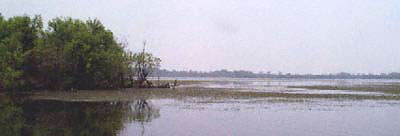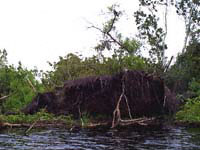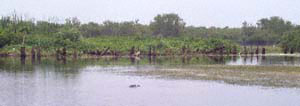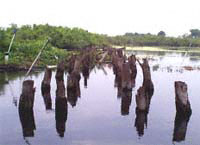Smoke on the Water
This
winter we had a lot of rain and water levels got quite
high on the river. Wet winter turned into warm spring
and plants burst into life at a tremendous rate. Then
it got hot. Real hot, and dry. Record high temperatures
were broken during all of June - with no rain. Lush vegetation
died of the heat and became
kindling. What
little rain fell brought lightning - which struck the dry
underbrush. Once started, the wind whipped the fire into
life, and with miles and miles of fuel available, shifting
winds, and no rain, there was nothing to stop the spread
of flames. Huge
sections of Interstate 95, US-1 and numerous cross roads
are shut down. Thousands of people have had to evacuate
their homes, often with only minutes notice. One entire
county is under mandatory evacuation orders. 
Looking across
Big Sawgrass in the smoke.
The
biggest fires are to the north of me, with a smaller fire
to the west, and a few even smaller fires locally. So far
there haven't been any fires in the marsh or the area around
camp, but the danger is not past.
Everything has been in a haze of smoke, and it's been so miserably hot that
Judy and I hadn't gone down river in a month. We wanted to see how the river
looked in the smoke, so we took a ride south.
|

Don't expect
to get a close-up of a gator from me until I get
a really good zoom lens!
|
When
we got to camp, we saw that my boat sat on one inch
of water in a deep, sticky muckhole. Normally there is
several feet of water over the muck in
this spot, but this was our first indication of how low
the water had gotten.
 An
Osprey looks An
Osprey looks
over Lake Sawgrass |
Intrepid
MarshBunnies that we are, we freed ourselves of the muckhole,
and headed south in a hot smoky haze. As
we passed over the deep hole by the old bridge, the water was
churned by mudfish rolling
and breaking the surface like they were gasping for air.
We saw a large alligator right away, and even though he
did swim away from us, he didn't bother to hide himself
under the water.
With
the water down, many creatures that lived deep in the marsh
have had to come to the river for water and food. The fires
have no doubt displaced many, as well.
Birds
seemed to be crowded into trees and along the shoreline.
An Osprey, a Hawk, and a Cormorant were all sharing one
prime location overlooking Lake Sawgrass.
|
 A
Rootball A
Rootball
|
Signs
of low water were everywhere. Old dead tree stumps that
had been underwater now stick up into the air. Rootballs
dot the shoreline where the taller Maples had grown. Maple
trees grow here and
there in the marsh, but their roots are shallow and when
the water drops and the earth dries out they become top-heavy.
A strong wind will blow them over, roots and all. The "soil" they
grow in is mostly made up of other plants and roots, and
when they topple they can peel up a big layer of sod.
Lake
Sawgrass was hazy with all the smoke hanging in the
air. Not even a breeze to stir the air and help us breath.
Little Sawgrass was badly grassed up and we thought we
might have to paddle through the last part, but managed
to keep the motor going until we hit the sandbar on the other side of the trestle. Since
the current flows strong here, the bottom is hard sand,
but the water is only about two foot deep.

This gator wasn't at all worried about being
stalked by MarshBunnies. |
Another
large 'gator was at the railway trestle. Once again, he
swam slowly away from us, but did not disappear underwater
for quite a while. Usually as soon as a 'gator sees you
(or notices that you see him) he will just sink out of
sight so slowly that you won't even believe he was there
to start with. If they are sunbathing they will slither into the water with a huge thrashing of their
tails, but they are just trying to scare you away long
enough to make their escape into the river. It looks quite
ferocious in a Tarzan movie.
<<< SideNote: What really looks cool is when the 'gator is sunning
on top of the grass in the lake - the grass is  holding it up, so it can't just sink out of sight,
and it is too far from the edge to just crawl into deeper
water. What they have to do then is to leap straight
up and dive headfirst through the thick grass to get
underneath it. We saw one do that on our return trip
across Big Sawgrass. holding it up, so it can't just sink out of sight,
and it is too far from the edge to just crawl into deeper
water. What they have to do then is to leap straight
up and dive headfirst through the thick grass to get
underneath it. We saw one do that on our return trip
across Big Sawgrass.
I'm
here to tell you that it's a thrilling sight to see
a 7 or 8 foot reptile that is mostly teeth launch itself
into the air just feet away from you. And, no, I didn't
get a picture of him. (That may have been when I snapped
the photo of the bottom of the boat, though.) >>>

Birds of a variety of species find plenty of
food to share in the drying grass. |
In
still areas the water has receded leaving mounds of
hydrilla and other water plants to steam in the dry,
hot air. Birds are feeding well on all the stranded minnows,
shrimp, bugs, frogs, snails, mussels.....some compensation
for the heat, I guess.
These grass mounds will rot and ferment and produce a really bad smell unless
rain comes to break it up and wash it downriver.
We only went a short way beyond the trestle. It was just too hot and smoky, and Judy kept telling me that if I
let us run out of gas I had to do all the paddling back to camp. Too hot.
 A few months
ago the water was over the top of the trestle.
A few months
ago the water was over the top of the trestle. |
Firestorms
don't happen too often - in 1985 the Palm Bay area
had a big firestorm, but it wasn't the size of these
recent fires. Wildfires clear out the underbrush occasionally,
and that is a healthy, natural happening in the marsh.
It clears out old, dead growth, enriches the earth and
allows for new growth.
Usually in the marsh burning areas are confined by water barriers and will
not spread too far. Intense firestorms leap boundaries of water, buildings,
or roads with great ease. The heat from the flames dries out further plantlife,
adding it to the fuel supply. A lot of the underbrush is Scrub Palmetto - a
type of palm with large fan-like fronds that is highly combustible and burns
hot and fast.
Dried
up muckholes can catch fire and smolder for a long time
below the surface before erupting into surface flames again.
Gas pockets that form and are trapped deep within the decomposed
muck add to the flammability.
The men and women who fought the firestorm of 1998 had quite a challenge before
them and they did a heroic job. top
of page |


